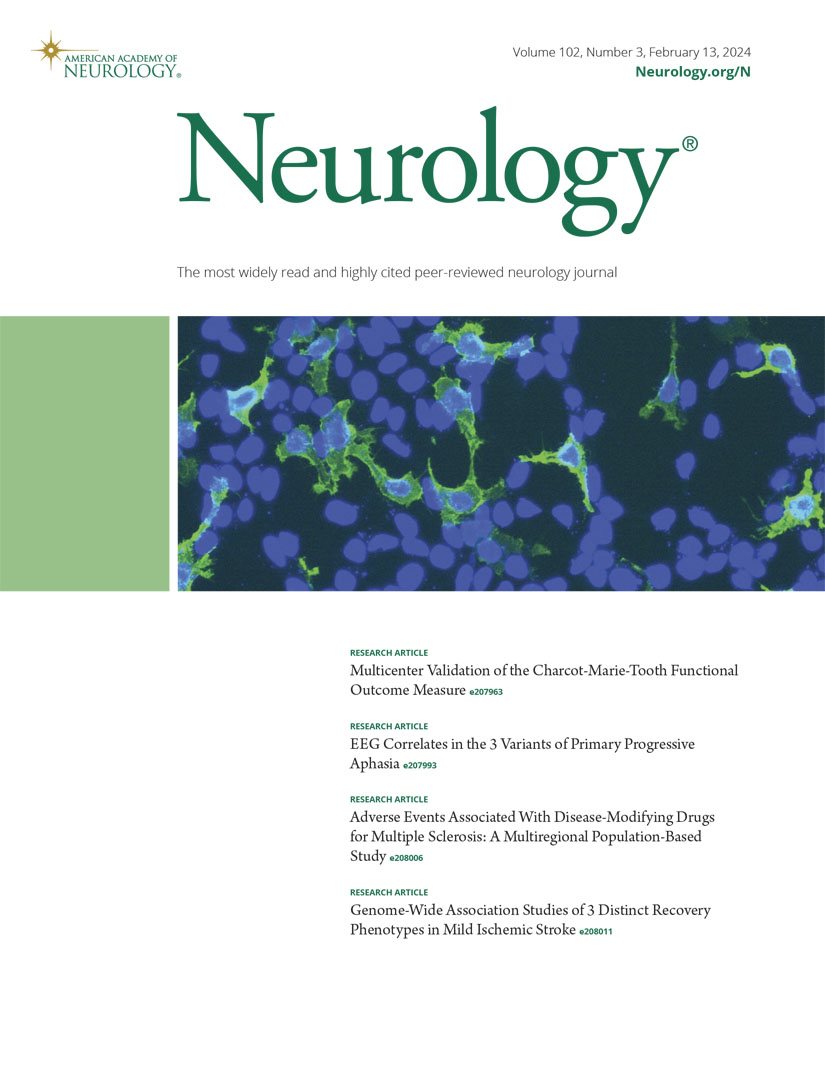脑动静脉畸形院前猝死:一项基于人群的研究
IF 8.5
1区 医学
Q1 CLINICAL NEUROLOGY
引用次数: 0
摘要
背景与目的脑动静脉畸形(AVMs)的院前意外死亡人数尚不清楚,因为现有的死亡率数据来自基于医院的队列。在这项研究中,我们旨在确定在医院内外的大型人群队列中与avm相关的死亡率和原因。我们假设avm很少会导致意外的院前死亡,当它们发生时,通常是由于出血而不是癫痫发作。方法在这项以人群为基础的横断面研究中,我们检查了1998-2015年赫尔辛基大学医院(HUH)地区与avm相关的死亡,包括尸检确定的确诊患者和未确诊的院前死亡个体。在芬兰,所有意外死亡和突然死亡都必须进行尸检。院前死亡通过尸检报告确定,这些报告来自国家死因登记册(使用ICD-10代码I60.8、I61.0-I61.9或Q28.0-Q28.3),已经诊断的患者来自赫尔辛基AVM登记册。年龄标准化检出率使用2013年欧洲标准人口(ESP)衍生的年龄特异性权重计算,95% ci来自二项分布的正态近似。结果1998年至2015年间,我们从全国死因登记数据中发现了HUH地区4例未确诊的院前AVM意外死亡(中位年龄41岁,50%为女性)。同一时期,HUH AVM数据库显示284例新诊断的AVM患者(诊断时平均年龄41.1岁[SD 18.0岁],48%为女性)。总共有6例avm相关院前死亡,其中2例为先前诊断的患者。6例院前死亡中有4例是AVM相关癫痫发作所致,2例是AVM出血所致。在首次经历avm相关出血的个体中(n = 168), 1.2%的患者因出血而院前死亡。同样,在诊断为avm相关癫痫发作的患者中(n = 69), 5.8%的患者院前因癫痫发作死亡。对于未破裂和破裂的动静脉畸形患者,检测后6个月病死率(ci)分别为5.8%(1.7%-10.8%)和11.9%(7.1%-17.3%)。avm粗检出率和esp标准化检出率(包括院前死亡)分别为0.80(0.71-0.89)和0.78(0.69-0.87)/ 100000人年。avm相关的院前死亡是罕见的,通常由癫痫发作引起。大多数与动静脉畸形相关的死亡发生在医院。本文章由计算机程序翻译,如有差异,请以英文原文为准。
Sudden Prehospital Deaths From Brain Arteriovenous Malformations: A Population-Based Study.
BACKGROUND AND OBJECTIVES
The number of unexpected prehospital deaths from brain arteriovenous malformations (AVMs) is unknown because existing mortality data are derived from hospital-based cohorts. In this study, we aimed to determine the rate and causes of AVM-related deaths in a large population-based cohort, both in and outside hospitals. We hypothesized that AVMs infrequently cause unexpected prehospital deaths, and when they do, it is typically due to hemorrhages rather than epileptic seizures.
METHODS
In this population-based cross-sectional study, we examined the AVM-related deaths within the Helsinki University Hospital (HUH) region during 1998-2015, including both diagnosed patients and undiagnosed individuals with prehospital deaths identified at autopsy. Autopsies are legally mandatory in Finland for all unexpected and sudden deaths. Prehospital deaths were identified through autopsy reports, which were obtained from the National Cause of Death Register (using the ICD-10 codes I60.8, I61.0-I61.9, or Q28.0-Q28.3), and the patients who were already diagnosed were identified from the Helsinki AVM Register. Age-standardized detection rates were calculated using the 2013 European Standard Population (ESP)-derived age-specific weights, with 95% CIs derived from the normal approximation of binomial distribution.
RESULTS
Between 1998 and 2015, we identified 4 unexpected prehospital AVM deaths in undiagnosed individuals (median age 41 years, 50% female) in the HUH region from the National Cause of Death Register data. For the same period, the HUH AVM database revealed 284 newly diagnosed patients with AVM (mean age at diagnosis 41.1 years [SD 18.0 years], 48% female). Altogether, there were 6 AVM-related prehospital deaths, 2 in previously diagnosed patients. Four of the 6 prehospital deaths were caused by AVM-related epileptic seizures and 2 by AVM hemorrhage. Among individuals experiencing their first AVM-related hemorrhage (n = 168), 1.2% experienced prehospital deaths due to hemorrhage. Similarly, of those diagnosed with AVM-related epileptic seizures (n = 69), 5.8% experienced prehospital deaths from seizures. For people with unruptured and ruptured AVMs, 6-month case fatality rates (CIs) from detection were 5.8% (1.7%-10.8%) and 11.9% (7.1%-17.3%), respectively. The crude and ESP-standardized detection rates of AVMs (including prehospital deaths) were 0.80 (0.71-0.89) and 0.78 (0.69-0.87) per 100,000 person-years.
DISCUSSION
AVM-related prehospital deaths are rare and often caused by epileptic seizures. Most AVM-related deaths occur in hospitals.
求助全文
通过发布文献求助,成功后即可免费获取论文全文。
去求助
来源期刊

Neurology
医学-临床神经学
CiteScore
12.20
自引率
4.00%
发文量
1973
审稿时长
2-3 weeks
期刊介绍:
Neurology, the official journal of the American Academy of Neurology, aspires to be the premier peer-reviewed journal for clinical neurology research. Its mission is to publish exceptional peer-reviewed original research articles, editorials, and reviews to improve patient care, education, clinical research, and professionalism in neurology.
As the leading clinical neurology journal worldwide, Neurology targets physicians specializing in nervous system diseases and conditions. It aims to advance the field by presenting new basic and clinical research that influences neurological practice. The journal is a leading source of cutting-edge, peer-reviewed information for the neurology community worldwide. Editorial content includes Research, Clinical/Scientific Notes, Views, Historical Neurology, NeuroImages, Humanities, Letters, and position papers from the American Academy of Neurology. The online version is considered the definitive version, encompassing all available content.
Neurology is indexed in prestigious databases such as MEDLINE/PubMed, Embase, Scopus, Biological Abstracts®, PsycINFO®, Current Contents®, Web of Science®, CrossRef, and Google Scholar.
 求助内容:
求助内容: 应助结果提醒方式:
应助结果提醒方式:


